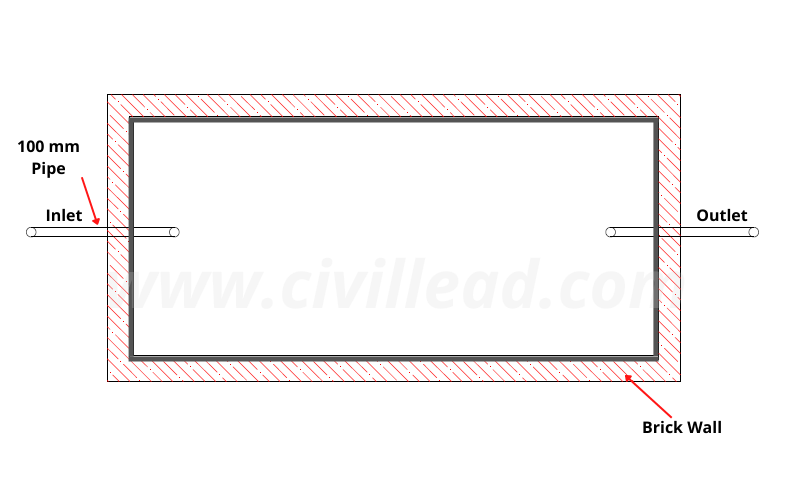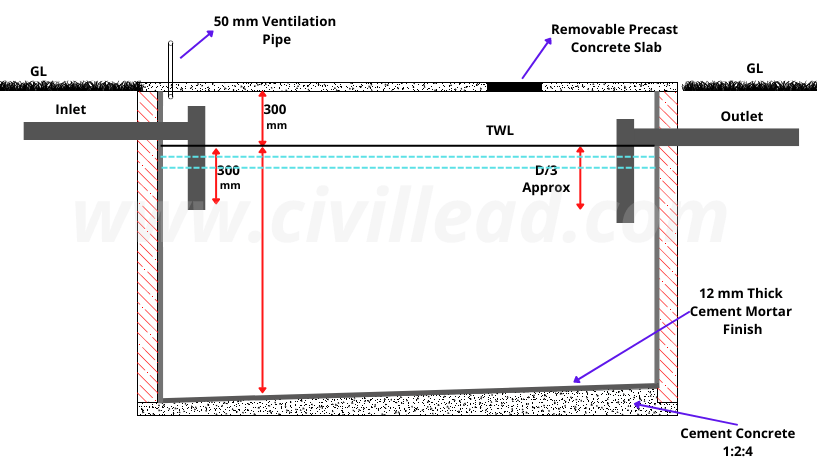Table of Contents
Septic Tank
A septic tank is a single-story underground, watertight tank in which sewage is retained long enough to allow sedimentation.
A septic tank is a primary sedimentation tank with a long detention time of 12 to 36 hours, as opposed to 2 hours in a regular sedimentation tank.
Septic tanks are suitable for the disposal of night soil in rural and urban areas which don’t have sewerage systems.
The septic tank design is such that it maintains the sewage in the tank for 24 hours. During this time, anaerobic bacteria decompose the excreta, liquefying and breaking it down, causing a small amount of sludge at the tank bottom and clear water called effluent to drain out.
However, adequate water should be available because it is necessary for the flow of night soil from the toilet facilities to the septic tank as well as the proper operation of the septic tank.
If there is no municipal drainage system in the area, septic tank effluent is usually disposed of by intake in the soil via a soak pit. The effluent is discharged if there is a municipal drainage line nearby.
Don’t use disinfectants such as phenyl, bleaching powder, and others for cleaning toilet facilities because they enter the septic tank and start killing the bacteria growth, reducing the rate of biological decomposition.
Septic Tank Design
The capacity or volume of the septic tank is decided by the number of users and sludge removal interval. Generally, sludge should be removed every two years.
The average waste generated by each human per day, including kitchen waste is taken 95 to 150 litres per head.
Generally, a septic tank is constructed with 23 cm thick brick or RCC walls and a foundation floor of cement concrete 1:2:4 having a thickness of 15 cm.

Both outer and inner wall faces and the floor top are plastered with 12mm thick cement mortar 1:3 mix. Inside the septic tank, all of the corners are rounded.
Waterproofing agents such as Impermo, Cem-seal, Accoproof, and others are mixed into the cement mortar at a rate of 2% by weight. It is also added to the concrete mix to prevent leakage.
The septic tank floor slopes from 1:10 to 1:20 towards the inlet side to collect and remove sludge. As a result, the outlet side floor will be higher than the inlet side floor.
Dimensions of a Septic Tank & Its Components

Length, Width, And Depth
According to IS:2470-1(1985), the septic tank should have a minimum width of 750 mm, a depth of 1000 mm below water level, a minimum freeboard of 300 mm, and a minimum water capacity of 1000 litres.
The length of a rectangular septic tank should be 2 to 4 times its width.
The minimum diameter for circular septic tanks should be 1.35 metres, and the operating depth should be 1 metre.
Detention period
In septic tank design, a detention period of 24 to 48 hours is considered depending on the average daily sewage flow. The effluent flow rate must be equal to the influent flow rate.
Inlet pipes
The design of septic tank inlets must be such that crude sewage is introduced with as little disturbance of settled sludge or surface scum as possible.
For tanks no wider than 1200 mm, a T-shaped dip-pipe no smaller than the nominal diameter of the input drain may be provided.
The pipe must be installed within the tank, with the top body part going up above the scum level and the bottom body part extending approximately 300 mm below the max water level.
Outlet pipes
For tanks, less than 1200 mm wide, the outlet pipe should be a 100 mm nominal bore dip-pipe positioned inside the tank.
The top body part grows above the scum level, and the bottom body part prolongs to approximately 1/3 of the water depth below the TWL. The outlet pipe’s invert must be 50 mm lower than the inlet pipe’s invert.
Partition or Baffle Wall
When a septic tank’s capacity exceeds 2000 litres, it can be separated into two chambers with a fixed, long-lasting partition.
The partition must be placed so that the first chamber’s capacity is twice that of the second chamber.
At about 300 mm below TWL, suitable openings (rectangular or circular) with a minimum dia of 100 mm and a maximum dia of 150 mm should be provided in the partition.
Cover and access holes
Each septic tank compartment should have a rectangular access opening no smaller than 455 x 610 mm or a circular opening no smaller than 500 mm in diameter.
Pipe Ventilation
Each septic tank must include a ventilating pipe with a diameter of at least 50 mm. The pipe should have a protective mosquito-proof mesh cage.
Septic Tank Construction
Floor
The tank floor must be waterproof and strong enough to withstand earth movement while supporting the tank weight, walls, and insides.
It should be built of concrete of at least M15 grade, with a minimum slope of 1: 10 towards the sludge outlet to assist desludging.
Walls
The thickness of the walls should be enough to provide sufficient strength and water resistance.
Brick walls should be at least 200 mm thick and plastered to a minimum thickness of 12 mm inside and out with a cement mortar ratio of 1:3. While stone the masonry wall should be at least 370 mm thick.
Slab
Depending on the tank size, the top of the septic tank is covered with a 75–100 mm thick RCC slab.
Man-holes with a diameter of 500 mm are given for check and desludging. In the case of a rectangular opening, the size is kept at 600 x 450 mm.
How to design a septic tank?
For easy learning, take an example of a small house of 20 people having a secure water supply from the municipal head-work at a rate of 120 litres/ person/ day.
The quantity of water supplied = Per Capita rate × Numbers of persons
= 120 × 20 litres per day
= 2400
Considering that 80% of water supplied becomes sewage, the quantity of sewage produced = 2400 × 0.8 = 1920 per day.
Considering the detention time of 24 hours, we have the sewage quantity generated during the detention time, which is tank capacity.
1920 × 24/24 = 1920 liters.
Now, considering the deposited sludge rate as 30 litres/capita/year and the cleaning period of one year. Then
30 × 20 × 1 = 600 liters.
Total Required Capacity of the tank = Capacity for sewage + Capacity for sludge
1920 + 600 = 2520 liter or 2.52 cubic meters (1 cubic meters = 1000 liters)
Considering the tank’s depth of 1.3 meters, we can calculate the tank’s surface area.
2.52/1.3 = 1.94 m2
Considering length to width is 3:1,
Length × width = Area
3B × B = 1.94
B2 = 1.94/3
B = √1.94/3
B = 0.8
So the width of the tank = 0.804
And the length of the tank = 3 × 0.804 = 2.412
Area of cross-section required = 2.412 × 0.804 = 1.939 say 1.94
Hence the dimension of the septic tank will be 2.412 m × 0.804 m × (1.53+ 0.3 ) m overall depth.
0.3 m assuming as free-board
Thus the size of the tank is = 2.412 m × 0.804 m × 1.6 m
Septic Tank Dimensions Based on Population
The following table lists suitable septic tank sizes for 4, 6, 8, 10, and 14 people.
| Numbers of Users | Length (meter) | Width (meter) | Depth (meter) | Capacity litres | Free Board (meter) | Cleaning period |
|---|---|---|---|---|---|---|
| 4 | 1.8 | 0.9 | 1.55 | 2000 | 0.3 | 2 |
| 6 | 2 | 0.9 | 1.55 | 2250 | 0.3 | 2 |
| 8 | 2.25 | 1 | 1.55 | 2800 | 0.3 | 2 |
| 10 | 2.5 | 1 | 1.7 | 3500 | 0.3 | 2 |
| 14 | 3 | 1.2 | 1.7 | 5000 | 0.3 | 2 |
Also, Read
Plumbing Traps – Purpose, 15 Types of Plumbing Traps
16 Types of Pipe Fittings In Plumbing System
Standard Room Sizes And Their Location In Residential Building
Building Construction Process Step By Step Start To Finish